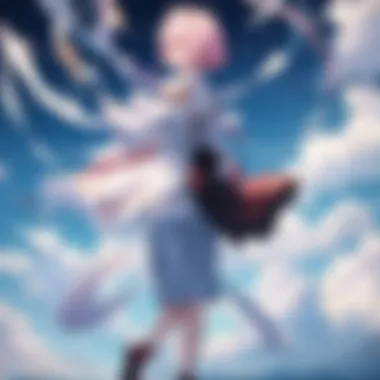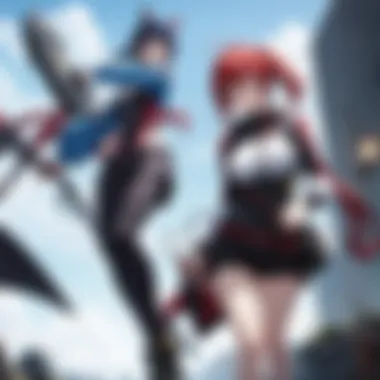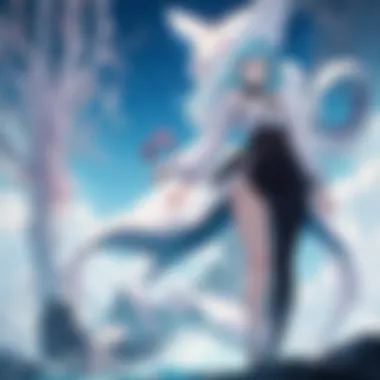Must-Watch Anime Series Available on Funimation


Intro
Anime serves not just as entertainment, but as a vivid exploration of cultural narratives. For those looking to explore the rich tapestry of anime on Funimation, you are in a rewarding journey. The platform provides a range of titles that span genres from action to romance, allowing various preferences to be met. Whether you are new to anime or a seasoned fan, Funimation’s collection is worth investigating. This article will highlight the gems available, offering insights into their story arcs, character dynamics, and thematic depth.
Episode Reviews
Summary of the episode
In approaching an anime, the episodes serve as the backbone of its narrative progression. Each episode unfolds layers of storytelling, often centering on the protagonist's journey and contrasting it with supporting characters. Many shows, like "My Hero Academia," bring viewers into a world filled with heroes and villains, while anime such as "Attack on Titan" delves into existential themes and societal collapse.
Analysis of key events
Key events in an episode can profoundly alter the viewer's perception. They push character development to new heights. For instance, in episodes of "Tokyo Revengers," pivotal moments lead to significant shifts in the timeline, influencing not just the characters affected but the overall storyline as well. Analyzing these events reveals motivations and opportunities for growth that ripple through to future episodes.
Discussion on character development
Character development in anime is often nuanced. Take "Demon Slayer" as an example. The protagonist, Tanjiro Kamado, evolves through his experiences, driven by compassion rather than revenge. Observing how characters interact and respond to critical situations enables a deeper understanding of their psyche. This development is essential in connecting viewers to the narrative.
Highlight memorable moments
Memorable moments can make or break a series. In "Fruits Basket," emotional scenes involving family and acceptance resonate deeply with the audience. These moments are often character-defining, and they elevate the viewing experience, making it more memorable. Analyzing such moments leads to a richer appreciation of the storytelling at play.
Character Spotlights
Background information on the character
Character spotlights provide insight into the figures who inhabit these extraordinary worlds. For instance, let’s consider Edward Elric from "Fullmetal Alchemist." His quest for redemption stems from a tragic past, which sets the stage for his ambitious goals and the moral dilemmas he faces.
Personality traits and unique quirks
Unique quirks help to define characters further. A character like L from "Death Note" exhibits strange habits, such as eating sweets while solving complex puzzles. These traits offer depth, making them more relatable and engaging to viewers.
Role in the storyline
Understanding a character's role in the storyline is crucial. Supporting characters, like Bakugo in "My Hero Academia," often have intertwined destinies with the protagonist. Their growth can enhance the main narrative arc, providing tension and resolution within the storyline.
Fan theories and speculations
The anime community often sparks intrigue with fan theories. Speculations about character fates or plot twists add a layer of engagement among viewers. For example, theories surrounding the ending of "Code Geass" continue to circulate, indicating the profound impact these characters have on fans.
Anime vs. Manga Comparison
Plot differences between the anime and manga
When examining adaptations, plot differences can reveal much about narrative pacing and theme execution. Series like "Naruto" differ significantly in content between the anime and its manga counterpart, affecting character arcs and story depth.
Art and animation quality
The art style can vastly differ between the two mediums. Manga often carries a more detailed portrayal, while anime relies on animation techniques to convey movement. For example, "Attack on Titan" is known for its stunning animation quality, bringing its intense battles and emotional scenes to life.
Character portrayal
Character portrayal may also vary; an anime may simplify certain aspects due to time constraints. Such traits that are prominent in manga might not find a place in the anime format. This can lead to some fans preferring the original manga.
Fan preferences and opinions


Fans often have divided opinions on which version is superior. Discussions on platforms like Reddit reveal a vibrant dialogue about preferences. Fans of more recent anime often lean towards the animated adaptations, while purists advocate for the manga version.
Industry News and Updates
Announcements on upcoming releases
The anime industry remains vibrant with constant news on upcoming releases. Funimation frequently updates its library with new titles, drawing attention to both highly-anticipated sequels and lesser-known series worth exploring.
Analysis of industry trends
Keeping an eye on trends within the anime industry helps to understand viewer preferences. For example, the rise of isekai genres and the return of classic adaptations illustrate shifting cultural interests.
Insight into the production process
Understanding the production process offers a fascinating lens into the crafting of anime. From voice acting to animation timing, each component plays a critical role in shaping the final product. Behind-the-scenes details can enhance appreciation for what viewers ultimately experience on screen.
Top Lists
Ranking of favorite characters or episodes
Top 10 lists remain popular among fans. Ranking favorite characters from series like "One Piece" demonstrates the emotional connections formed through personal journeys.
Compilation of best fight scenes
Compiling the best fight scenes from shows like "Dragon Ball Z" sparks debate and excitement among fans. These sequences often serve as significant narrative points, showcasing character growth and resolve.
Comparison of different genres within anime and manga
Genres like slice of life, shounen, and shoujo each have unique storytelling conventions. They provide a diverse offering on Funimation, appealing to a wide array of viewers. Understanding these genres enhances viewing choices, guiding fans toward titles that may resonate.
Audience polls and feedback
Engaging with audience polls allows viewers to express preferences openly. This feedback can help direct future content, ensuring platforms remain attuned to viewer desires.
Anime has the power to resonate, provoke thoughts, and entertain. Understanding its depth enriches the viewing experience.
Intro to Funimation
Funimation has established itself as a key player in the anime landscape, serving as a dominant platform for streaming anime content. The significance of this platform cannot be overstated, particularly for viewers who seek to engage with both popular and niche titles. Funimation offers a vast library that spans across various genres, making it a go-to destination for enthusiasts. This introduction aims to underline how Funimation's offerings cater to diverse tastes and preferences, addressing the importance of selecting the right anime to enhance the viewing experience.
The Role of Funimation in the Anime Industry
Funimation plays a pivotal role in the anime industry, not just as a distributor but also as a cultural curator. Founded in 1994, it has contributed immensely to the popularization of anime outside Japan. It licenses and translates numerous series, bringing them to a Western audience that may not have had access to such content otherwise. This accessibility is crucial for introducing new fans to the medium. The platform also ensures that dubbed versions are available, offering alternatives for those who prefer them over subtitled content.
Moreover, Funimation promotes lesser-known titles alongside blockbuster hits. This strategy encourages viewers to explore beyond mainstream options, enhancing their understanding and appreciation of anime culture as a whole. The platform introduces unique stories, showcasing the creativity and variety inherent in anime. Its engagements with fans through events, merchandise, and social media further solidifies its impact on both the industry and community.
Navigating the Funimation Platform
Navigating Funimation's platform can be straightforward once familiar with its layout. The home page offers trending shows and a curated selection of genres, assisting viewers in discovering new content. Search functions are intuitive, enabling users to find specific titles easily. This usability is key for both new viewers and seasoned fans, as it minimizes the time spent looking for interesting content.
The platform features personal watchlists, allowing viewers to save their favorite shows for later viewing. This enhances the overall experience by offering flexibility in viewing habits. Additionally, Funimation facilitates community-building through social features that promote dialogue among fans. Overall, these aspects contribute to a rich user experience that mirrors the diverse offerings available in its library.
Genre Overview
Understanding genres is crucial for navigating the vast world of anime available on platforms like Funimation. Each genre has its unique characteristics, themes, and emotional undertones that resonate with different audiences. By exploring various genres, viewers can discover stories that align with their preferences. Moreover, knowing the genre helps to contextualize the elements of storytelling, character development, and visual style that are present in each series. This framework allows anime enthusiasts to make more informed viewing choices and enhances their overall viewing experience.
Shonen Anime


Shonen anime primarily targets a younger male demographic, although its appeal extends far beyond this group. These series often feature action, adventure, and themes of friendship and perseverance.
Some popular shonen titles on Funimation include My Hero Academia and One Piece. These series frequently showcase protagonists who overcome substantial challenges, appealing to the audience's desire for growth and redemption. Key elements in shonen include epic battles, powerful abilities, and tournaments, all of which fuel excitement and anticipation. These characteristics not only bolster character development but also create engaging narratives that keep viewers invested.
Shojo Anime
Conversely, shojo anime caters mainly to a young female audience, although it finds appreciation among diverse viewers. This genre focuses on romance, emotional relationships, and personal struggles.
Series like Fruits Basket and Yona of the Dawn showcase the intricacies of relationships. They intertwine drama with character growth, highlighting emotional journeys that resonate with the viewer. Shojo narratives often involve strong character arcs and relatable situations, allowing audiences to connect deeply with the storylines. Themes of love, friendship, and self-discovery dominate this genre, making it appealing for many viewers.
Slice of Life
Slice of life anime captures everyday experiences and ordinary moments in a way that resonates with audiences. These series often do not follow a specific goal or endpoint, focusing instead on character development and interactions.
March Comes in Like a Lion illustrates the complexities of life, emphasizing themes of loneliness and personal growth. Slice of life stories can be calming and reflective, often providing a gentle pace that encourages viewers to contemplate their own experiences. This genre can include elements of comedy, drama, and romance, enhancing the emotional landscape through relatable narratives.
Supernatural and Fantasy
Supernatural and fantasy genres create worlds that extend beyond reality, often incorporating magic, mythical creatures, and alternate dimensions. Such settings appeal to viewers’ imaginations and provide a break from the mundane.
Titles like Demon Slayer: Kimetsu no Yaiba and Re:Zero - Starting Life in Another World explore themes of heroism, sacrifice, and moral struggles. The fantastical elements often serve as metaphors for real-life challenges, allowing audiences to reflect on their experiences through a different lens. These narratives can be grandiose in scope and delve into rich lore and world-building, drawing viewers into immersive and captivating stories.
Science Fiction
Science fiction anime explores futuristic themes and concepts, often dealing with technology, space exploration, and the implications of scientific advancements. This genre challenges viewers to think critically about the direction of humanity and the ethical considerations surrounding innovation.
Series such as Steins;Gate and Cowboy Bebop bring forth complex narratives and thought-provoking themes. Often, these stories delve into the consequences of time travel or the intricacies of human relationships in a technologically advanced world. By presenting speculative scenarios, science fiction anime encourages discussions about potential futures and our responsibilities.
Top Recommendations
In the landscape of anime, identifying standout series requires a keen understanding of what makes titles memorable and engaging. The section on Top Recommendations serves as a vital centerpiece of this article. It highlights not only popular series but also lesser-known finds that deserve a wider audience. By including a curated selection of anime, this section aims to guide viewers through Funimation's extensive library. The recommendations offer unique narratives, intricate character development, and impressive artistry, making it easier for viewers to find shows that suit their preferences and stimulate thoughtful discussion.
Popular Titles to Consider
When discussing popular titles available on Funimation, a few series consistently capture attention and accolades. Here are some suggestions:
- My Hero Academia: This series stands at the forefront of popularity. It combines action, character growth, and a well-structured world that captivates fans of all ages.
- Attack on Titan: Known for its gripping narrative and complex themes, it presents a dystopian world where humanity fights for survival against giant creatures. The psychological depth of characters makes it a compelling watch.
- Demon Slayer: Blending breathtaking animation with an emotional story, it follows young warriors battling demons in a richly developed setting.
- Death Note: A classic that grapples with moral dilemmas involving justice and power. Its thrilling plot offers gripping twists that keep viewers engaged.
These titles not only reflect broad appeal but also contribute to ongoing conversations in the anime community. Their themes resonate deeply, making them worthy of both critical and popular acclaim.
Hidden Gems
In addition to popular series, exploring hidden gems can introduce viewers to unique storytelling that may have gone unnoticed. Here are some lesser-known titles that deserve attention:
- The Promised Neverland: While initially appearing as a children's tale, it unveils layers of suspense and horror, offering a thought-provoking narrative about survival and freedom.
- March Comes in Like a Lion: An introspective series that delves into mental health and personal growth. It’s a heartfelt exploration of loneliness and connectivity.
- A Place Further Than the Universe: A journey of friendship and self-discovery, it follows a group of girls aiming to reach Antarctica, touching on themes of adventure and ambition.
- KonoSuba: God's Blessing on This Wonderful World!: A comedic take on isekai tropes, it offers humor through its quirky character dynamics and adventure.
These hidden gems reflect diverse storytelling methods and perspectives, enriching the anime experience for viewers willing to explore beyond mainstream hits. Each of these recommendations encourages deeper engagement with the medium and enhances the appreciation for the craft of anime storytelling.
Character Analysis
Character analysis plays a fundamental role in understanding the broader narrative and thematic depth of anime. It allows viewers to engage with the characters on a more personal level, fostering a connection that enhances overall enjoyment. Characters in anime are often multifaceted, encompassing complex motivations, emotional struggles, and growth arcs that resonate deeply with audiences.
Exploring character development not only highlights the writing strength but also signifies how these characters drive the story forward. Insight into protagonists and antagonists reveals how their interactions and conflicts shape the narrative, often reflecting larger societal themes and personal experiences that viewers can relate to.
Moreover, analyzing character traits helps viewers discern between different genres and styles, allowing them to identify what appeals to them specifically. Hence, a thorough character analysis contributes significantly to the understanding and appreciation of anime as an art form.


Complex Protagonists
Complex protagonists are at the heart of many compelling anime narratives. These characters often embody intricate personalities that evolve throughout the series. Viewers are drawn to their flaws, strengths, and internal conflicts, which create a sense of realism and depth.
In many cases, the complexity of protagonists serves as a reflection of the human experience. For instance, characters like Shinji Ikari from Neon Genesis Evangelion display vulnerabilities that resonate with audiences grappling with existential dilemmas. Similarly, in Attack on Titan, Eren Yeager’s transformation from a hopeful youth to a morally ambiguous figure illustrates the shifting nature of ideals influenced by trauma and conflict.
Engaging with these complex characters allows fans to explore deeper questions about their motivations, ethical dilemmas, and the environment shaping their decisions. This layer of analysis can spark discussions and debates, enriching the viewing experience. By understanding what makes these protagonists relatable, viewers can form stronger emotional ties and gain insights into the overarching messages of the series.
Memorable Antagonists
Memorable antagonists not only provide conflict but also enhance the themes and character arcs within a series. Unlike one-dimensional villains, well-crafted antagonists often have their own motivations and backstories that contribute to their complexity. This depth can evoke empathy or provoke critical thought regarding their actions.
For instance, in Fullmetal Alchemist: Brotherhood, characters like King Bradley exhibit a duality that blurs the line between good and evil. His calm demeanor juxtaposed against ruthless decisions showcases how power can corrupt and lead to profound consequences. Similarly, Death Note’s Light Yagami challenges the notion of justice as he attempts to impose his morality through lethal means, forcing viewers to question their own beliefs.
Analyzing these antagonists highlights their role in driving the story. They often mirror the protagonists' struggles and can even serve as catalysts for change, pushing characters to confront their own flaws and rethink their values. This complexity makes memorable antagonists not just obstacles but essential components that elevate the narrative, enriching the overall anime experience.
Art and Animation Styles
Art and animation styles play a crucial role in defining the essence of anime. The visual appeal is not just about aesthetic value; it profoundly affects storytelling, character development, and audience engagement. Well-executed art styles can evoke emotions, highlight themes, and even act as a narrative device in itself. As audiences explore Funimation's offerings, understanding these styles becomes even more important. This knowledge enhances their viewing experience and aids in recognizing the artistic choices made by creators.
Traditional Techniques
Traditional animation techniques in anime include hand-drawn art and cel animation. Before the digital age, animators relied heavily on these methods. They used transparent sheets to showcase characters against intricate backgrounds. This labor-intensive process created a certain warmth and depth that resonates with many fans. Classic examples include titles like "Akira" and "My Neighbor Totoro". The uniqueness of hand-drawn elements fosters a sense of nostalgia and craftsmanship.
In traditional animation, each frame is painstakingly created, ensuring a fluid movement that can captivate viewers. This method inherently includes a personal touch, as artists invest time and skill into every detail. Moreover, traditional techniques often facilitate a unique stylistic signature for various series. For instance, studio Ghibli's works are immediately recognizable due to their distinct art style.
Innovative Approaches
With advancements in technology, innovative approaches to animation, such as CGI and digital art, have gained prominence. These methods allow for hyper-realistic visuals and special effects, broadening the scope of storytelling. Series like "Attack on Titan" showcase these techniques, offering viewers a visual spectacle that might be unattainable through traditional methods alone.
Innovative animations do come with their critiques. While they enhance graphical fidelity, some argue they can compromise emotional connection. The challenge lies in balancing technology with the traditional hand-drawn aspect that many fans cherish. Nonetheless, shows embracing these modern techniques can create compelling experiences that redefine the boundaries of anime.
"The art of anime is not just what is seen on the screen, but also how it influences our emotions and understanding of the story."
Cultural Impact of Anime
The significance of anime transcends mere entertainment. As a cultural phenomenon, anime has created a unique space in the global art and entertainment landscape. This influence can be observed in several dimensions, including its portrayal of societal issues, diverse storytelling techniques, and its embrace of philosophical themes. Furthermore, the impact of anime on societal norms and values is worth exploring as it both reflects and shapes the perspectives of audiences worldwide.
Anime's Influence on Global Pop Culture
Anime has significantly permeated global pop culture, reshaping the way narrative forms are perceived and appreciated. Works such as Naruto, Attack on Titan, and Dragon Ball Z fostered a widespread interest, initiating dedicated fan communities across various platforms. Cosplay, conventions, and fan art are examples of how anime culture has inspired creative expression all over the world.
- Fashion and Merchandise: Popular titles have driven fashion trends, with apparel and merchandise becoming mainstream. The demand for anime figurines, posters, and clothing signifies a vibrant market, catering to enthusiasts and casual viewers alike.
- Media Crossovers: Collaborations between anime and other entertainment forms, such as video game franchises, music albums, and television shows, reflect how anime influences diverse cultural trends. This makes anime not only a form of storytelling but also a rich source of inspiration for various industries.
- Social Media Phenomenon: Platforms like Reddit and Facebook contain numerous groups solely dedicated to anime discussions, showcasing how deeply embedded anime is in social discourse. The exchange of ideas about plot developments, character relationships, and philosophies invites a participatory culture among viewers.
"Anime isn't just a genre; it's a global language, transcending barriers and connecting fans around the world."
Contributions to the Art Scene
Anime's contribution to the art scene is multifaceted. It has introduced distinctive styles and techniques that innovate traditional animation forms, setting the bar for creativity and artistry.
- Visual Aesthetics: Character design and vivid environments are notable features of anime. Series like Your Name and Spirited Away have garnered attention not only for their narratives but also for their stunning visual compositions. The artistry often emphasizes emotional impact, enhancing the storytelling.
- Soundtracks: Anime soundtracks play a critical role in enhancing the viewer's experience. Notable films and series boost their emotional resonance through carefully selected music, ranging from orchestral pieces to contemporary pop songs. This connection between music and narrative enhances engagement and emotional depth.
- Influence on Western Animation: Notable anime styles have influenced Western animation, inspiring studios to explore similar themes and techniques. Shows like Avatar: The Last Airbender reflect anime’s impact on character development, cultural contexts, and animation styles.
Finale
The conclusion of this article holds significant importance for understanding the vast landscape of anime available on Funimation. It encapsulates the essence of what has been discussed, aligning the various genres and themes with the viewing preferences of audiences. Highlighting the value of Funimation's offerings not only showcases popular titles but also emphasizes lesser-known gems that deserve attention. This comprehensive overview equips viewers with insight, stimulating interest in exploring anime beyond mainstream selections.
Final Thoughts on Funimation's Offerings
In reflection, Funimation stands as a pivotal platform in the realm of anime, delivering a diverse collection that caters to varying tastes. Each genre explored caters to unique themes and narratives, appealing to a wide range of audience members. The depth of character development showcased in many titles fosters a connection between viewers and the stories being told. Furthermore, the platform's curated selection offers both accessibility and depth, making it easier for fans and newcomers alike to find content that resonates with them.
"Anime is not just a form of entertainment; it is a cultural phenomenon that transcends borders and connects people globally."
The benefits of engaging with Funimation extend beyond simple enjoyment. They include opportunities for cultural exchange and even educational value, especially in learning about Japanese language and culture. As the anime landscape continues to evolve, viewers are encouraged to revisit both classic and contemporary titles, elevating their viewing experience. Ultimately, Funimation’s expansive library may serve as a gateway for further exploration in this vibrant and multifaceted medium.







